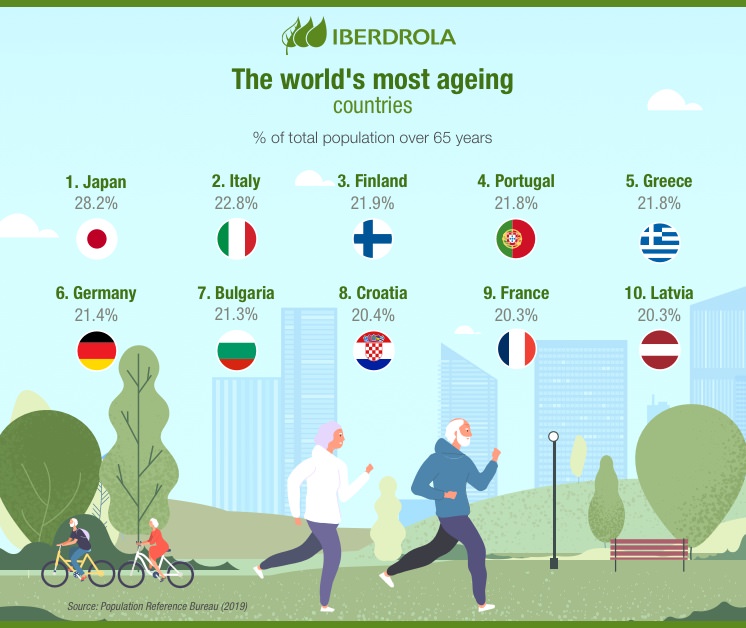Silver economy
Silver economy, older people will be the engine of the economy of the future
In the Europe of 2060, one in three inhabitants will be over 65. A similar trend of increasing life expectancy and reversal of the population pyramid will be followed by the rest of the developed countries on the planet. The forms of consumption will therefore change and older people will become the engine of the so-called silver economy..

The baby boomers who are people born between 1935 and 1960, grew up in a post-war world, took to the streets in May 1968, brought down the Berlin Wall and today run the world and the economy with figures like Angela Merkel, German Chancellor, or Bill Gates, co-founder of Microsoft, at the head. However, the members of this generation are not weighed down by the years; on the contrary, they feel as young and as full of life as their children. In addition to having more free time, especially those who have already reached retirement, they have eleven times more wealth than millennials, according to data from the American Federal Reserve.
INCREASED LIFE EXPECTANCY
The secret of this second youth is linked to the spectacular increase in life expectancy in recent decades. World Bank and World Health Organization (WHO) statistics indicate that in 2020 we live an average of 72.5 years, 20 more than in 1960, and that the total population over 60 will have doubled by 2050 compared to 2000.
The main consequence of increased longevity, coupled with the general decline in the birth rate worldwide, is the reversal of the population pyramid. This means that there are more and more older people and less young people, something that was verified in 2018 by an extraordinary occurrence: that year, the over-65s surpassed the under-fives for the first time in the history of humanity, as revealed by the United Nations (UN).

SEE INFOGRAPHIC:: The world's oldest countries [PDF] External link, opens in new window.
WHAT IS THE SILVER ECONOMY
The silver economy includes all those economic activities, products and services designed to meet the needs of people over 50. This concept, derived from the so-called silver market that emerged in Japan, — the country with the highest percentage of people over 65 — during the 1970s to refer to the senior market, brings together sectors as diverse as health, banking, automotive, energy, housing, telecommunications, leisure and tourism, among others.
One of the keys to the silver economy will be in technological innovation. Advances in home automation, Artificial Intelligence (AI), Internet of Things (IoT), eHealth and other services typical of smart cities, arouse the interest of a public that is mature but that is too young to feel old. Below we review the features that best define the consumers of the silver economy:
- They have high purchasing power and are free of economic burdens.
- They use their time to do what they always wanted: to travel, enjoy new experiences, give themselves a treat, etc.
- They are active people who like to take care of themselves, play sports, eat well, be fashionable and have fun.
- They are loyal to their brands, consume more than young people and require more specific and personalised products and services.
- They have more free time and like to take advantage of it with cultural and leisure activities.
CHARACTERISTICS OF THE ECONOMY OF THE FUTURE
The silver economy still has many challenges to overcome today in order to become a true driver of the economy, but the economy of the future will be led by older people and will have the qualities listed below, among others:
Glocal
The economy is glocalising and in the coming decades it will be common for companies to think globally and act locally.
Inclusive
The economy of the future will have to correct the imbalances of globalisation in order to manage a just transition and distribute wealth more equitably.
Digital
The internet and new technologies will play a leading role in the Fourth Industrial Revolution and will be the centre of business innovation and the gateway to international markets.
Circular
Economic activities will seek ways to reduce the wastage of raw materials and resources such as food, water, technology and energy by boosting the circular economy.
Eco-friendly
With the creation of green jobs, the green economy will contribute to social equity, improve welfare and reduce resource scarcity and environmental risks.
Collaborative
The economy of the future will be more caring because it will encourage the exchange of products and services for shared benefit.
OPPORTUNITIES OF THE SILVER ECONOMY
The European Commission predicts that in addition to generating billions in profits, the silver economy will significantly contribute to job creation and the European Union's (EU) gross value added (GVA) by 2025. Below, we analyse the main opportunities offered by the silver economy:
- Silverisation of sectors. New products and services will emerge on the market adapted to the needs of older people. To achieve this, it will be important to rely on gerontechnology, which is the area of technology that studies human ageing.
- A boost to new professions. The ageing of the population will lead to the creation of jobs and the emergence of careers related to the silver economy, for example in the area of care for the elderly.
- Investment in strategic plans. The rise of the senior economy will encourage governments to invest in solutions that improve health care and the independence of the elderly, for example.




